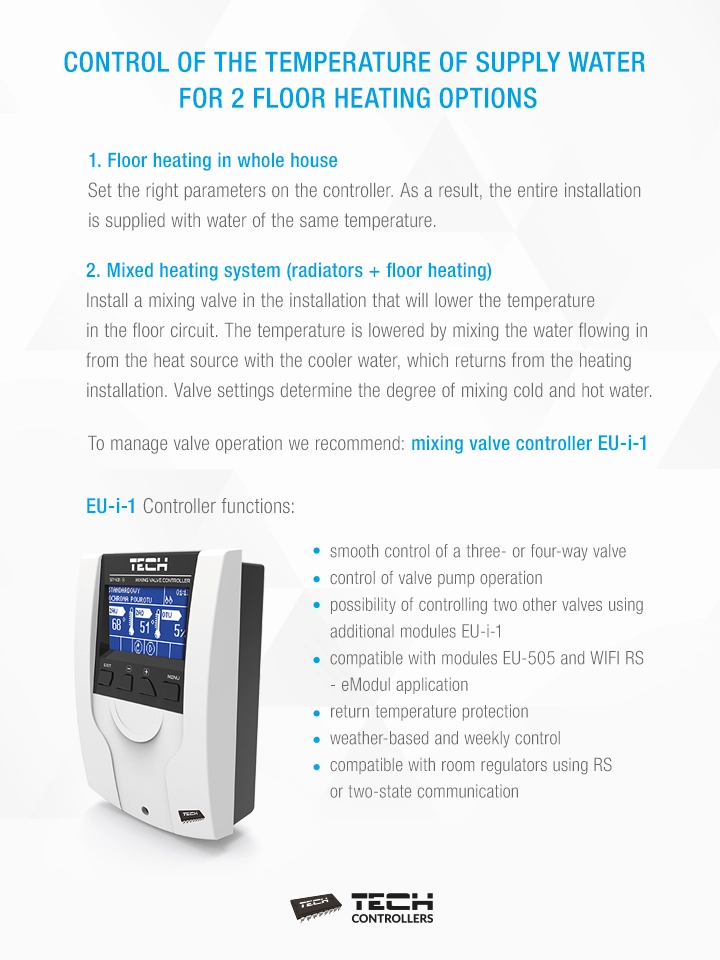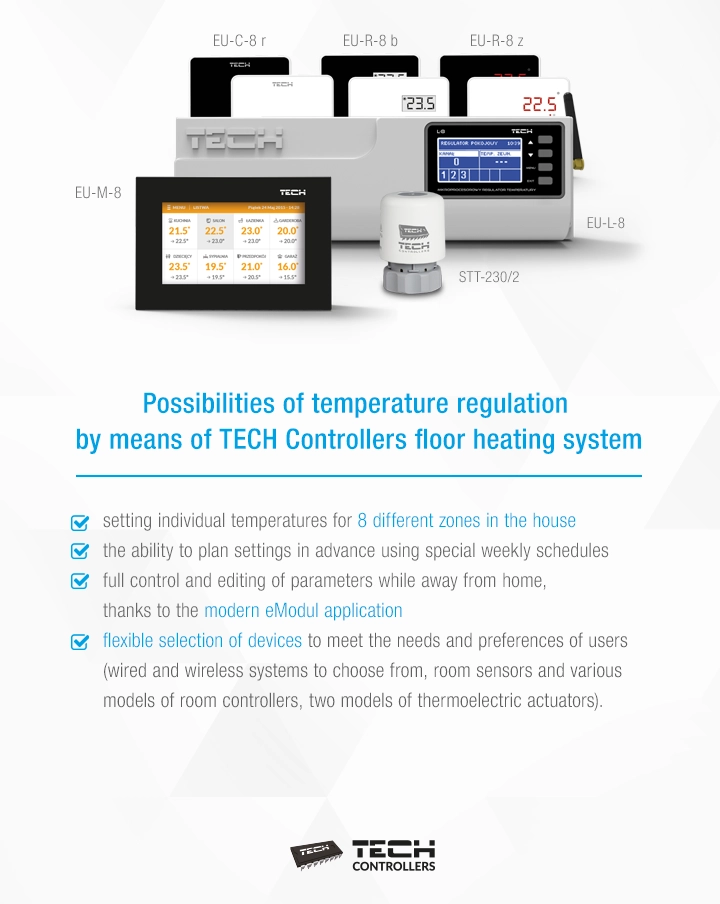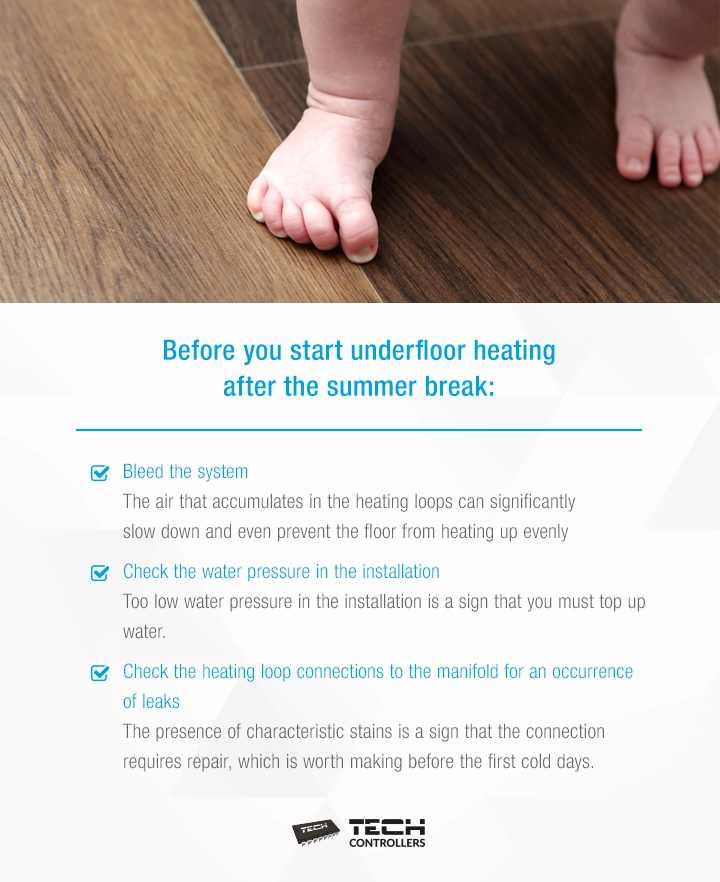Balancing your underfloor heating system as a way to achieve greater thermal comfort and lower heating bills.
Healthy temperature distribution in rooms, energy efficiency, functionality and limitless possibilities of interior design are just a few of the many advantages of choosing underfloor heating for your home. However, for such a heating system to bring noticeably higher thermal comfort and energy savings, the most important thing is to properly balance the entire system. How can we balance our underfloor heating system?
Supply water temperature
One of the most important parameters which needs to be configured in the underfloor heating system is the temperature of the water feeding the system, which affects the floor temperature. Setting appropriate temperature protects the floor from damage and ensures proper heat transfer. We should not exceed the permissible, pre-defined value of 55° C in this respect. Higher supply water temperature does not only increase the risk of damage to the system, but it also leads to greater heat loss translating into higher bills and general discomfort of home dwellers.

The use of a valve in the heating system together with skilful management using a mixing valve controller is a way to supply the underfloor heating system with water at an acceptable temperature despite the fact that the heating system itself is fed water at high temperature (directly from the radiator system). It works as follows: a sensor placed at the underfloor heating supply measures the supply water temperature. When the temperature is too high, the thermostatic valve closes, causing an increase in the water supply from the return of the heating system, thereby cooling the supply water. Once the alarm temperature of the valve sensor has been reached, the pump stops. When the temperature measured by the sensor is too low, the thermostatic valve opens, which means that less cool water returns to the supply manifold. In this way, less cool water flows through the floor valve.
Supply temperature versus outside temperature
It is worth remembering that maintaining the flow temperature within the pre-set values is not enough to ensure optimum thermal comfort. You also need to adjust the supply temperature to the weather conditions outside. Higher supply temperature of the underfloor heating system will be advisable during severe frost. The same temperature during the transitional period between seasons would lead to overheating of the rooms, and thus it is associated energy loss. In order to adjust the supply temperature to current weather conditions, the user may select and subsequently edit the heating curve.
Floor control centre - the temperature ideally suited to your needs
The second key factor affecting the bills and the thermal comfort of the floor is temperature regulation. Pleasant warmth in rooms where underfloor heating is used can be achieved by proper heating management. Water underfloor heating control systems can communicate with a heating device in a traditional way by using a cable, or wirelessly. It is important that they are easy to use and safe. The basic set ensuring efficient heating control system by TECH Controllers includes:
- thermostatic actuator controller - a central panel controlling the operation of control devices installed in particular rooms.
- temperature sensors or room controllers, enabling the user to maintain a different temperature in each room, depending on individual needs.
- thermoelectric actuators for controlling thermostatic valves in manifolds (two versions to choose from: STT-230/2 and STT-230/2 S). They open or close the water supply to the heating loops depending on the signal sent by the controllers.
How does it work? The temperature controller sends appropriate signal to the master controller depending on whether the room temperature is too low or too high. The main controller, in turn, activates thermoelectric actuators which are mounted on the manifold. In this way the heating loop is closed or opened. An easy-to-use control panel ensures the efficiency and effectiveness of the entire heating system. When the pre-set temperature is reached, the regulator disables the boiler, which prevents excessive heat or energy loss. Setting different temperature values in rooms depending on their function complies with the principle of prudent heat management and reduction of heating expenditure, while maintaining everyday comfort.

Hydraulic balancing of the underfloor heating system as a solution to the problem of under-heated rooms.
Different rooms in the house have different power requirements, which translates into a different length of the underfloor heating loop and different hydraulic resistance. The floor temperature can be adjusted by choosing appropriate pipe spacing between 10 and 30 cm (depending on the pipe diameter, heat loss in the room or the type of floor), as well as balancing the flow in individual loops. In other words, each heating loop should be fed a water stream with a specific flow rate resulting from the required thermal power. For this purpose, the heating systems feature control valves for measuring hydraulic resistance of individual water circuits. A very practical solution is to use a manifold equipped with valves. A flow meter, which can be connected to the underfloor heating manifold, enables the user to precisely adjust the flow. The flow can be measured based on the flow meter readings. Manual hydraulic balancing involves reducing the water flow in the loops with the lowest resistance and at the same time increasing the flow in the longest loops with the highest hydraulic resistance. The goal is to achieve the greatest possible water flow in the longest loops and reduce the low in the shortest ones.
Starting the underfloor heating system after summer break
The effectiveness of the underfloor heating system also depends on how it is used. Summer is a great time for conducting system maintenance, especially if we've been using it for a long time.

If the underfloor heating system has already been used for a long time, it is a good idea to flush it. This is a good way to get rid of various types of sediment accumulating inside the pipes and increase the efficiency of the heating system during the heating season.
Balancing underfloor heating system as a way to achieve greater savings
Underfloor heating allows you to achieve high thermal comfort while reducing heating bills. Water underfloor heating means lowering home maintenance costs, eliminating the factors causing excessive air moisture as well as ensuring high thermal comfort. Failing to carry out installation correctly or balance the heating system results in malfunctioning, which can lead to overheating of under-heating of the rooms. Therefore, it is crucial to control the heating agent temperature and the flow (hydraulic balancing) as well as to set the room temperatures properly. Compliance with all the rules concerning installation and balancing of the underfloor heating system will allow you to enjoy full thermal comfort resulting from having warm floors.

